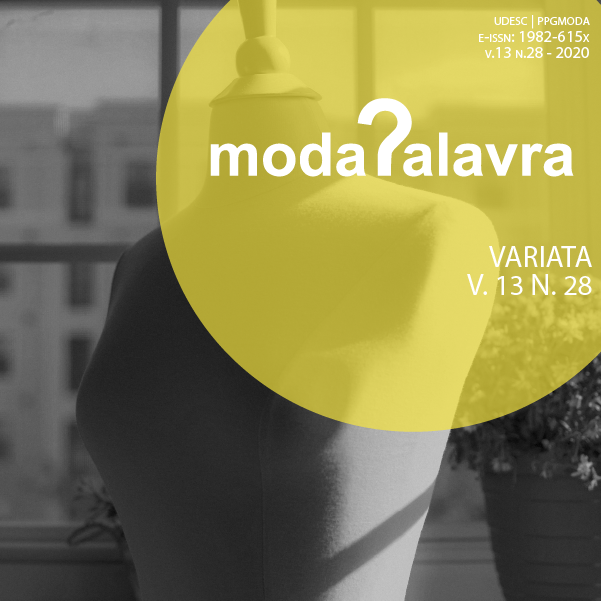The trajectory of egress in a fashion course: curriculum and professional performance
DOI:
https://doi.org/10.5965/1982615x13272020233Keywords:
ashion curriculum, graduates, professional performanceAbstract
This research aimed to understand the trajectory of the graduates of the first class of the fashion course of a public university. With this purpose we analyze the curriculum relations of the initial formation and the fields of action of the graduates from the formative course. Documents from the Course Feasibility Project (1996) and the graduates questionnaires (2001) were analyzed from the thematic analysis of Bardin (2016). The results demonstrate the technical characteristics of the curriculum due to th e practical context of the regional industrial clothing industry. Regarding the graduation course of the graduates demonstrated update to the Fashion market acting in intellectual fields between the service industry, industry and MEI.Downloads
References
ANTUNES, Ricardo. Adeus ao trabalho? Ensaio sobre as metamorfoses e a centralidade do mundo do trabalho. 3. ed. São Paulo: Cortez, 1995.
ANTUNES, Ricardo. Adeus ao trabalho? Ensaio sobre as metamorfoses e a centralidade do mundo do trabalho. 16. ed. São Paulo: Cortez, 2015.
BONADIO, Maria Claudia; MARINHO, Maria Gabriela, WAJNMAN, Solange. Apresentação - Dossiê Moda e conhecimento: interfaces com as ciências humanas e a comunicação. Iara, v. 3, n. 3, 2010. Disponível em: http://www1.sp.senac.br/hotsites/blogs/revistaiara/index.php/vol-3-no3-ano-2010/. Acesso em: 17 dez. 2019.
BRASIL. Presidência da República, Casa Civil. Lei nº 9.394, de 20 de dezembro de 1996. Estabelece as diretrizes e bases da educação nacional. Brasília, 20 dez. 1996. Disponível em: http://www.planalto.gov.br/ccivil_03/LEIS/L9394.htm. Acesso em: 16 dez. 2019.
BRASIL. Ministério da Educação. CNE. Resolução n. 5, de 8 de março de 2004. Brasília, 8 mar. 2004. Disponível em: http://portal.mec.gov.br/cne/arquivos/pdf/rces05_04.pdf. Acesso em: 09 set. 2019.
BRASIL. Ministério da Cultura. Programa Cultural para o Desenvolvimento do Brasil. Brasília: MinC, 2006. Disponível em: http://rubi.casaruibarbosa.gov.br/bitstream/20.500.11997/6837/1/119.pdf. Acesso em: 17 dez. 2019.
BRASIL. Ministério da Cultura. Plano Cultural da Moda. Brasília: Ismália Afonso, SPC/MinC, 2013. Disponível em: https://bit.ly/2PdCzkh. Acesso em: 17 dez. 2019.
CHRISTO, Deborah Chagas. CIPINIUK, Alberto. Estilista? Designer de Moda...ou um Designer de objetos do vestuário? Dobras, v. 7, n. 15, p. 13-22, 2014. Disponível em: https://dobras.emnuvens.com.br/dobras/article/view/69/69. Acesso em: 17 dez. 2019.
GUIMARÃES, Maria Eduarda Araújo. Moda, Cultura e identidades. In: ENECULT- ENCONTRO DE ESTUDOS MULTIDISCIPLINARES EM CULTURA, 4, 2008, Salvador. Anais [...]. UFBA: Salvador, 2008. Disponível em: http://www.cult.ufba.br/enecult2008/14326.pdf. Acesso em: 17 dez. 2019.
LENZI, Cristiano Luís. O “Modelo Catarinense” de desenvolvimento: uma ideia em mutação? Blumenau: Edifurb, 2000.
MATTOS, Maria de Fátima da Silva Costa Garcia. (Org.) Pesquisa e formação em Moda. São Paulo: Estação das Cores e Letras, 2015.
SACRISTÁN, José Gimeno. O currículo. Uma reflexão sobre a prática. Tradução de Ernani F. da Fonseca Rosa. 3. ed. Porto Alegre: Artmed, 2000.
SANCHES, Lucinéia. Os moldes da moda: um estudo sobre o estado dos cursos de formação em Moda no Brasil. 2006. 121 f. Dissertação (Mestrado em Educação) - Universidade Regional de Blumenau, Blumenau, 2006.
SANT’ANNA, Mara Rúbia. Teoria da Moda - Sociedade, Imagem e Consumo. 2. ed. São Paulo: Estação das letras e cores, 2016.
SILVA, Barbará Cravo da. NASCIMENTO, Luís Cláudio Portugal. Apontamentos acerca da integração entre conteúdos de Design e de Moda no percurso de implementação do Design de Moda. Projética, Londrina, v. 3, n. 1, p. 110-118, 2012. Disponível em: http://www.uel.br/revistas/uel/index.php/projetica/article/view/12266/11334. Acesso em: 17 dez. 2019.
TREVISOL NETO, Orestes. A institucionalização científica do campo da Moda no Brasil: estudo baseado nas instituições, produtores e produtos científicos. 2015. 191 f. Dissertação (Mestrado em Ciência da Informação) - Universidade Federal de Santa Catarina, Florianópolis, 2015. Disponível em: https://repositorio.ufsc.br/xmlui/bitstream/handle/123456789/135394/334677.pdf?sequence=1&isAllowed=y. Acesso em: 17 dez. 2019.
Downloads
Published
How to Cite
Issue
Section
License
Copyright (c) 2020 Emanuella Scoz, Marcia Regina Selpa Heinzle, Gabriela Poltronieri Lenzi

This work is licensed under a Creative Commons Attribution-NonCommercial 4.0 International License.
When submitting an article for publication in ModaPalavra e-periodico, the author (s) agree (s) with the following terms:
- Authors maintain the copyright in their manuscripts and grant the journal the right of first publication, with work simultaneously licensed under the Creative Commons Attribution-NonCommercial 4.0 International, which allows sharing the work with the acknowledgment of authorship and the initial publication in the journal without payment ;
- Authors may use the same results in other publications after the first publication, provided that they indicate ModaPalavra e-journal as the original publication medium;
- Authors are authorized to take additional contracts, separately, only after the original publication in ModaPalavra e-journal, provided they indicate ModaPalavra e-journal as the original publication medium;
- Authors are allowed and encouraged to publish and distribute their work online (eg in institutional repositories or on their personal page), only after the editorial process and the first publication, provided they indicate ModaPalavra e-journal as the original publication medium;
- To indicate ModaPalavra e-journal as the original publication medium, authors should use the following text template: "This article was originally published by ModaPalavra e-periodical, under a CC BY NC license, in its volume [insert volume] number [insert number] in the year of [insert year], and can be accessed at: http://www.revistas.udesc.br/index.php/modapalavra/ ";
- The opinions expressed in the articles are the author’s sole responsibility, not necessarily reflecting the journal’s opinion. The publication of any material that is owned and held in copyright by a third party, including – but not limited to - articles, photos or drawings was previously authorized by their representatives to be published in ModaPalavra e-journal.









